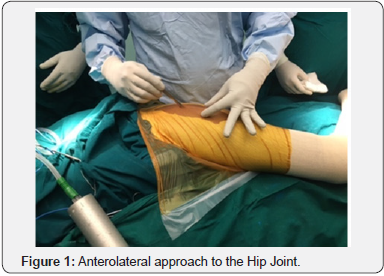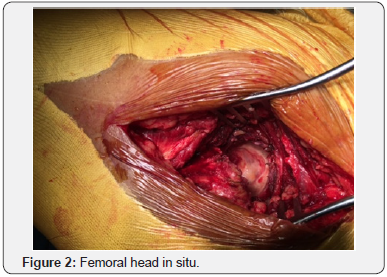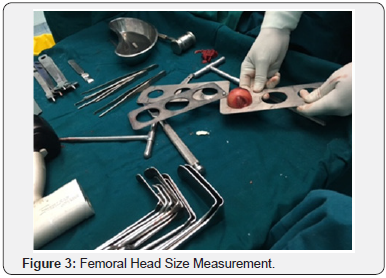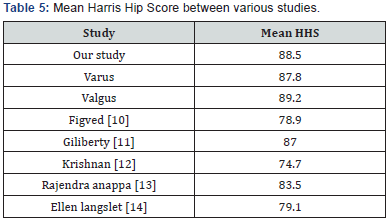Juniper Publishers- Open Access Journal of Case Studies
Association between Femoral Stem Positioning and Functional Outcome in Hemiarthroplasty of Hip Joint
Authored by Rohan Bhimani
Abstract
Introduction: Intracapsular neck of femur fractures are common in geriatric population. Women are more predisposed to these fractures in comparison to men. Hemiarthroplasty is the most common treatment for displaced fractures of the femoral neck in the elderly. The aim of this study was to evaluate the effect of varus and valgus position of femoral stem and its comparative functional outcome in bipolar hemiarthroplasty. In addition, the study also helps to determine comparative range of motion between valgus and varus group.
Material and Methods: This is a prospective study in which 32 consecutives cases of intracapsular fracture neck of femur, between the age of 50-90 years were subjected to bipolar hemiarthroplasty and followed up for 6 months. All patients were examined radiologically and clinically post-operatively for functional outcome with Harrsi Hip score. Statistical data analysis was conducted using SPSS 18.0. Student t test and chi square test were used to compare the level of significance with p value ≤ 0.05 considered as statistically significant.
Result: The mean range of motion did not vary significantly between valgus and varus groups. In addition, the mean Harris Hip Score also did not show any significant difference between valgus and varus groups. The average Harris Hip Score was 86.5. Furthermore, in both the groups, majority of the patients showed Excellent outcome. Overall, we had excellent results in 18 (56.25%), good in 11 (34.4 %) and fair in 3 (9.4 %) patients.
Conclusion: Hemiarthroplasty using uncemented bipolar prosthesis is a good procedure for the elderly and provides early rehabilitation. There is no statistical difference between Harris hip score of varus and valgus group of femoral stem positioning.
Keywords: Hemiarthroplasty; Bipolar prosthesis; Neck of femur fracture; Hip joint
Introduction
The incidence of femoral neck fractures, one of the most common traumatic injuries in elderly patients increases with age [1,2]. Assuming that the age-related incidence will increase by only 1% per annum, the number of hip fractures in the world will reach 8.2 million in 2050. The femoral neck fractures are rare among young people which is only 2% in patients under 50 years of age. Eighty percent of hip fractures occur in women and 90% in people older than 50 years [2].Various modalities of treatment are employed, but the problem remains an enigma unsolved until today [3]. Prolonged immobilization in elderly will jeopardize the life span of the patient and further complicate the problem. Thus, complete immobilization to achieve a bony union is nearly obsolete and surgeons resort to early ambulatory procedures by surgery.
The blood supply to the neck and head of the femur is extensive, intricate and complicated [4]. Fracture healing mainly depends on the good blood supply. As the blood supply to the neck is frequently damaged, it jeopardizes the treatment of these fractures and thus the healing process. Fractures of neck of femur have always presented as a great challenge to orthopaedic surgeons. They are often associated with co-morbid conditions like hypertension, cardiac problems, diabetes and dementia. This combined with prolonged immobilization due to fractures leads to increased morbidity and mortality [5]. Hence, early mobilization after hemiarthroplasty is essential in intracapsular neck of femur fractures. Undisplaced intracapsular hip fracture are almost invariably treated with internal fixation [6]. However; most of the fractures are displaced and occur predominantly in elderly female patients. Bones are osteoporotic in elderly patients. Despite the ubiquitous nature of these fractures, there is still a surprising degree of variation in treatment [5,6].
Hemiarthroplasty is the most common treatment for displaced fractures of the femoral neck in the elderly and is associated with better functional outcome and fewer reoperations than internal fixation [6]. A large number of prostheses have been used with or without cement but no definite conclusions have been made, regarding which type of arthroplasty is preferred [6,7]. There is some evidence of inferior short-term results, with decreased mobility and more pain when using an uncemented implant and concerns regarding fixation problems with uncemented stems in osteoporotic bone have been raised [6,7]. The bonding between prosthesis and femur is dependent upon bony in growth when cement is not used whereas in cemented prosthesis, cement forms a solid bond between prosthesis and femoral bone. The advantages of cementing are a less post-operative mid-thigh pain, as the prosthesis is firmly fixed within the femur and a reduced long-term revision rate from loosening of the prosthesis. Major side effects of cement are cardiac arrhythmias and cardiorespiratory collapse, which occasionally occur on application. These potentially fatal complications are caused either by embolism from marrow contents forced into the circulation or by a direct toxic effect of the cement. During insertion, femoral stem can go into varus or valgus position. The purpose of this study is to evaluate the effect of varus and valgus position of femoral stem and its comparative functional outcome in bipolar hemiarthroplasty. In addition, the study also helps to determine comparative range of motion between valgus and varus group.
Materials and Methods
Between August 2016 and July 2017, 32 patients with intracapsular fracture neck femur in the age group 0f 50-90 years were consecutively selected. We prospectively gathered their data. The exclusion criteria included patients managed conservatively for other medical reasons and those with neurovascular compromise. There were 16 males and 16 females included in the study. There were 16 patients under each category of Valgus and Varus femoral stem position respectively. All patients gave written consent to be a part of this study.
Preoperatively, radiological assessment of the femoral head size is done by comparing it to the opposite side. Surgeries were performed under combined spinal and epidural anaesthesia. Patient was positioned in lateral decubitus with fractured side up (Figure 1). Anterolateral approach to hip joint was carried out andthe anterior capsule of the hip joint was incised in a T-shaped fashion by cutting the attachment of the capsule to the acetabulum. The head of the femur was extracted, using the skid after doing osteotomy of the neck (Figure 2). Intraoperatively, the size of excised head of femur was measured using templates and trialled with prosthesis (Figure 3). After adequate preparation, the selected size of pre-sterilized (gamma irradiated) uncemented bipolar prosthesis was press fitted into the prepared medullary canal, ensuring a snugly fit prosthesis in 15° of anteversion and without any movement between the shaft & stem. Movements of the limb at the hip joint was then checked for any loosening at the head-acetabular interface or at the shaft-stem interface. Drains was kept post-operatively. The suturing technique involved layer by layer closure till the skin. Sterile dressing subsequently followed the closure of the wound.



Postoperatively, the primary operative site was checked 48 to 72 hours after surgery and drain removed. Physiotherapy started on first post-operative day and mobilization with walker was done by 4th day. Check radiograph was taken after 48 hours and limb length discrepancies were assessed, both clinically as well as radiologically. Patient was asked to follow-up after 14 days for suture removal and then subsequently at 6 weeks, 3 months and 6 months. Harris hip score was recorded for range of motion at each visit from 6th week. Evaluation of positioning of the tip of the stem using conventional AP X-ray of Hip joint was evaluated. A line was drawn parallel with the prosthesis stem until it angled with the anatomical axis of the femur. Alignment was divided into three groups: valgus alignment (> 3° valgus), neutral (3° varus to 3° valgus) and varus (> 3° varus). Thus, patients were divided into 3 groups depending on stem position.
Statistical Analysis
Statistical data analysis was conducted using SPSS 18.0. Student t test and chi square test were used to compare the level of significance with p value ≤ 0.05 considered as statistically significant.
Result
In our study of 32 patients undergoing uncemented bipolar hemiarthroplasty, the mean age of patients in Valgus Group was 64.0 ± 4.7 Years and for Varus Group was 67.9 ± 7.8 Years (Table 1). The age distribution did not differ significantly between Valgus and Varus groups. Sixteen males and females respectively were included in the study.Majority of the cases from both the study groups had injury due to domestic fall i.e. Valgus Group, 75.0% and Varus Group, 81.2% (p= 0.999) (Table 2). The mean Flexion, External rotation, Abduction and Adduction range of motion did not differ significantly between Valgus and Varus Groups (P-value > 0.05). In addition, the mean Harris Hip Score also did not show any significant difference between Valgus and Varus Groups (P-value > 0.05) (Table 3). The average score according to Harris Hip Score was 86.5. Furthermore, in both the groups, majority of the patients showed ‘Excellent’ outcome (Valgus Group - 62.5% cases, Varus Group - 50.0% cases and p > 0.05). Overall, we had excellent results in 18 (56.25 %), good in 11 (34.4 %), fair in 3 (9.4 %) patients (Table 4).




Discussion
Fractures of the femoral neck are a common problem in the elderly, after a trivial fall due to osteoporosis and is more common in females than males due to post-menopausal osteoporosis. The number of intracapsular fractures are increasing due to increase in life expectancy linked to advances in the medical field. The treatment modalities for such fractures has evolved from a simple Austin-Moore prosthesis to a complicated total hip replacement. A thorough understanding of the needs of the patient, condition of the joint along with the financial aspect of the surgeries can help the orthopaedic surgeon chose the appropriate procedure for the patient.
In our study, the average age was 65.95 years with a range of 58-85 years. Equal number of male and female patients were represented in the study. In addition, there was equal distribution between varus and valgus group. Past studies have shown that more female patients were part of the study in comparison to male due to post-menopausal osteoporosis. This was observed in series by Rogmark et al. [8] which had a female patient percentage of 79, 73.4% in Anders Enocson et al. [9] and 74% in series by Figved et al. [10]. Moreover, our mean Harris hip score was comparable to other studies previously published (Table 5).

None of our patients develop thrombo-embolic episode, limb length discrepancy, infection, dislocation and peri-prosthetic fractures which was observed in other studies [9,10]. The limitation in this study was shorter duration of follow up.
Conclusion
We conclude that hemiarthroplasty using uncemented bipolar prosthesis is a good procedure for the elderly and provides early rehabilitation. There is no statistical difference between Harris hip score of varus and valgus group.
For more articles in Open Access Journal of Case Studies please click on: https://juniperpublishers.com/jojcs/index.php



No comments:
Post a Comment